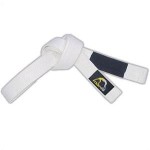 White belt is a time in your jiu-jitsu life that consists of incredible excitement and wonder. Each class brings with it the awe of a new technique or the solution to a frustrating problem. The mind of a white belt is an empty canvas waiting to be graced with brush and paint to create a masterpiece. Despite, however, the wonderment of so many new things the white belt years are also an intricate jumble of limbs and frustrating baffle of strategies and concepts. So what is a white belt to do? Below are two specific advices of value that can help you, the white belt, make sense of it all.
White belt is a time in your jiu-jitsu life that consists of incredible excitement and wonder. Each class brings with it the awe of a new technique or the solution to a frustrating problem. The mind of a white belt is an empty canvas waiting to be graced with brush and paint to create a masterpiece. Despite, however, the wonderment of so many new things the white belt years are also an intricate jumble of limbs and frustrating baffle of strategies and concepts. So what is a white belt to do? Below are two specific advices of value that can help you, the white belt, make sense of it all.
#1 Master Movements and Mat Fitness
Most of the biomechanics that create leverage in Brazilian jiu-jitsu will not feel instinctive to the white belt student. In addition, the muscle usage and flexibility are distinctive to the art of jiu-jitsu so even very able-bodied athletes coming to bjj from other sports will have an awkward period of adjustment while they become accustomed to the biomechanical specific demands of bjj.
This is why every jiu-jitsu instructor on the planet has a warm up designed to instill the fundamental movements into the students – drills like shrimping the length of the mat. Idyllically, the warm up should include few to no calisthenics (pushups and jumping jacks) and be mainly comprised of drills, movements, and technical flow chains that directly relate to how a body must move for bjj. In this way the movements of jiu-jitsu are imprinted upon the brain making learning the moves of jiu-jitsu far easier. Much like in the Karate Kid, when Daniel-son must ‘paint the fence’ only to later learn Myagi has been teaching him karate all along!
In this same way, all of the warm-up movements we perform every day subtly equip the white belt with the biomechanics essential to learning and executing arm locks, triangles, sweeps, passes, and scrambles. By the time a white belt encounters the instruction of technique in class, they have already performed the move 100 times in a ‘virtual’ setting!
#2 Take Time To Learn The Steps
Like the Waltz or the Tango, there is a rhythm to the art of jiu-jitsu, an underlying tempo that makes the art a thing of beauty to perform and watch. And just like a dance, each part of your body will have an important task in the execution of any technique – ‘what should my right hand be? And my feet – do they move like this? What about my hips? Do I apply leverage here?’
As a white belt there are many questions.In order to make simpler complicated technique sequences break it down like step by step. Like you might learn a dance or even ‘paint by numbers’. As a white belt in jiu-jitsu the majority of your training time will be spent learning new techniques and that means learning the technical details for move and then repeating those details enough times so as to imprint the movements into your central nervous system so that you may execute them with little to no thought.
Two important tips to help your ‘learn the steps of the dance’, (1) always practice the technique as if you are under water, your movements slow and precise and (2) talk your way through the move –‘step one: grab here, step two: break posture, step three: post my foot on the hip…’
Training in this way will not only make your white belt years a less frustrating experience but it will also will help you in the development of leverage, timing, and technique.
About the Author:
Jeff Reese, Gracie Jiu-jitsu black belt, has had the honor of learning from two generations of Gracie family members including Royce, Royler, Rodrigo, Rolker, Ralek, Rener, and Ryron; he teaches at Gracie NEPA in Scranton, PA
